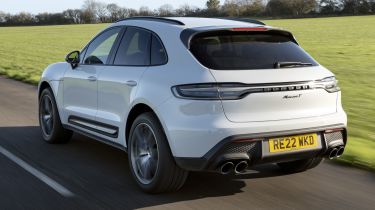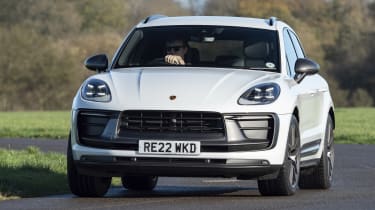Porsche Macan - Engines, performance and drive
The S and GTS’s twin-turbo V6 is an excellent powertrain, but the turbo-fours in the base and T models just aren’t potent enough
It’s worth remembering that like Porsche’s other SUV, the Cayenne, the Macan isn’t a bespoke model like its sports cars. Instead, the Macan actually sits on a platform borrowed from the previous-generation Audi Q5. Yet despite this less-than-idea start point, Porsche did a comprehensive job of re-engineering the elements it had to work with, giving the Macan a distinctive feel peppered with plenty of Porsche-like traits in its steering, handling and chassis balance.
All of its basic dimensions and suspension components are bespoke to the Porsche, with a wider track, longer wheelbase and lower roof height all giving the Macan an almost coupe-like stance on the road. As well as looking different, it also helps the Macan feel exceptionally stable at speed, underpinned by impressive body control and very high grip levels on account of its wide tyres.
It’s equally as impressive at slower speeds in and around town, where you notice the smoothness of the dual-clutch automatic gearbox. It doesn’t fuss or lurch as you move away from a standstill which means it’s more usable and relaxing to drive than some rivals.
Conventional steel coil springs and passive dampers are standard on the base Macan, with T and S models upgrading to three-way PASM adjustable dampers. Like many Porsches, the Macan’s ride quality is always firm, but rarely deteriorates into being brittle or uncomfortable. Its main priority is to keep the body under complete control, something it does with great success despite weighing between 1,845kg and 1,930kg, depending on the engine. Models fitted on PASM dampers widen the suspension’s bandwidth without going too far in either direction.
Top-spec GTS models swap this arrangement out for an air-spring setup, again fitted with corresponding adjustable dampers. The GTS has the most dynamically focused setup, sitting 15mm lower than cars on steel springs, dropping another 10mm when you press the Sport button. It’ll also rise by 40mm when you select the off-road mode. Unfortunately, despite the extra variability, the air-springs themselves take away a certain level of connection from the road, and in combination with the GTS’s standard 21-inch wheels can be a little too stiff in Sports mode.
More reviews
Car group tests
- Maserati Grecale vs Porsche Macan: 2023 twin test review
- Porsche Macan T vs BMW M135i: 2023 twin test review
In-depth reviews
Road tests
Of course, the different suspension systems are just the tip of the iceberg when it comes to the Macan’s chassis, with high-spec inclusions like a torque-vectoring rear differential (PTV Plus), Power Steering Plus and even carbon ceramic brakes (PCCB) on the options list.
Yet it’s the fundamentals that the Macan gets right. The heavily weighted and accurate steering needs the smallest of inputs before the car instantly turns in with the sort of precision and poise you just don’t expect in a jacked-up car this size. But, it’s worth mentioning that the Macan isn’t as refined as many premium rivals, especially on larger wheels.
There are huge reserves of grip, and combined with standard four-wheel drive, the Macan unlocks a level of confidence that few rivals can match. The chassis needs a certain level of performance to unlock its potential – a level of performance that the four-cylinder Macans just don’t have – with the capable GTS dynamically closer to a high-end hot hatchback, than a high-riding SUV. Its explosive V6 engine is a delight to exploit as you accelerate out of corners, making a full-blooded noise as it revs right up to the red line.
0-62mph acceleration and top speed
The Macan’s engine range is a story of two halves, split between in-line four-cylinders and a V6. Putting it simply, the four-cylinder engine found in the latest Macan and Macan T just aren’t powerful enough to overcome the car’s weight or offer a dynamic driving experience to challenge the car’s outstanding grip levels. The engine itself is an impressive unit in other applications, namely the Golf GTI and Audi S3, but when trying to fight around 400kg of extra mass, 261bhp just isn’t enough. Some clever launch control antics, all-wheel drive and a sharp-shifting seven-speed dual-clutch PDK transmission do make for an impressive-sounding 0-62mph acceleration time of 6.2 seconds, but on the road it does not translate, often hunting through gears trying to find power that’s just not really there.
The Macan S and GTS are a different case. Rather than a VW-sourced four-cylinder, the V6 is a through-and-through Porsche unit, co-developed with Audi for use in some of its RS models. In the Macan S, the twin-turbocharged 2.9-litre V6 petrol engine produces a much more substantial 375bhp, and thanks to a clever hot-V turbocharger layout, is both more responsive and surprisingly efficient, making it only 2mpg thirstier than the four-cylinder Macan T. This is reflected in its 0-62mph time of 4.8 seconds (with the Sport Chrono package), but felt even more acutely on the road as the same PDK transmission doesn’t have to work nearly as hard to deliver considerably more performance.
Sitting at the top-of-the-range is the Macan GTS, packing an even more potent 434bhp tune, essentially replacing the now-defunct Turbo model. It manages the 0-62mph sprint in 4.3 seconds – a hugely impressive time – but if you’re under the impression that it will keep up with rivals like the Alfa Romeo Stelvio Quadrifoglio or BMW X3 M you might be disappointed because both of those admittedly more expensive rivals deliver considerably more performance from their own turbocharged, six-cylinder engines.
Don’t bother looking for any hybrid or diesel options, though, as the Macan is strictly petrol-powered only.
Which Is Best
Cheapest
- Name5dr PDK
- Gearbox typeSemi-auto
- RRP£57,895
Most Economical
- Name5dr PDK
- Gearbox typeSemi-auto
- RRP£57,895
Fastest
- NameGTS 5dr PDK
- Gearbox typeSemi-auto
- RRP£76,395






